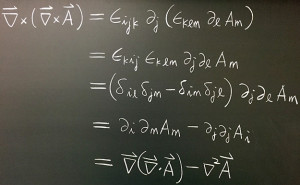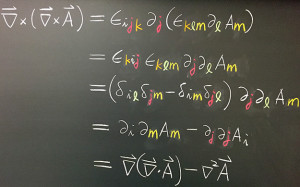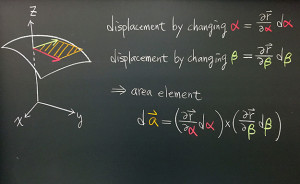by Yi-Chuan Lu, Physics
Teaching Effectiveness Award Essay, 2016
Physics is a subject that describes nature by using precise mathematical language. When we teach physics, it is inevitable to prove equations in addition to explaining the physical phenomena, but it is also the time when students get frustrated. For example, during the past three semesters I have been teaching Physics 110A (Electromagnetism and Optics) as a GSI, and we dealt with a lot of vector-field manipulations. In one discussion section I taught them how to use index notations to prove a vector identity like that shown in Figure 1. It was still very clear when I explained what the identity meant physically until I wrote down the lines of equations on the board. From their faces I knew my students were lost since there were too many repeated indices. Even though the vector identity itself has a clear intuition, when we do real calculation it becomes complicated.
I spent some time thinking about how to make the calculation as easy to follow as possible. I could simply type the entire calculation into a PDF file and asked students to read it line by line, but I also wanted to have a real discussion and make sure everyone was clear about it. So what I did was, I went to the supplier office in the physics department and got color chalk designed for board work. In the following discussion sections, I made all the repeated indices the same color, as shown in Figure 2. The students were amazed since now it was really clear which indices got contracted and canceled (like the indices j and m in the second from the last line), and what were left over and became a vector quantity (like the index i in the same line). At first it might seem time-wasting to change colors when I was writing, but actually I saved even more time on explaining the calculations, and students could follow me immediately from line to line. Afterwards I even tried using color chalk in different topics, as shown in Figure 3 that illustrates the structure of a curved surface in the three-dimensional space. The red and green arrows represent the displacements in two independent directions governed by two parameters, and therefore span an orange area, and these ideas are expressed just naturally by the colored texts.
I received many comments for this small trick in the course evaluation. Here are some: “His color-coded explanations are always drawn beautifully and are optimally organized.” “His presentation of the material during discussion was incredibly clear and understandable; he used different color chalk which I thought was very helpful and sadly was something that I’ve never seen another GSI did before.” Indeed, this trick not only makes the board work clear, but also helps students improve presenting their work in a nice way. After the middle of that semester, I saw some students started using color pens to express the crucial parameters or variables in their homework. I think they had seen the convenience of this trick and begun to appreciate it.




